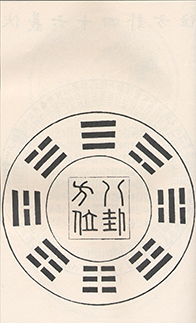
Ba Gua Fang Wei Tu
By Robert L. Felt, Co-author Understanding Acupuncture
The Yuan dynasty (1264 to 1368 CE) followed the Song and was a period when the Mongols under Ghenghis and Kublai Khan controlled China. The Yuan is the period of the famous bronze acupuncture statues, devices that symbolize the relative stability of acupuncture’s base of data. Books of this era place 303 points on the 12 regular channels and 51 on the two medial channels for a total of 654 of the now accepted 670 acupoints. There was also a further development in the specialized practice of moxibustion. While there would be continuous interchange with China’s neighbors, and the Mongols would translate the Nan Jing into their own language, few developments of note occurred in China’s neighboring countries. Indeed, it would not be until the Ming dynasty of 1368 to 1643 CE that Chinese traditional medicines would be revitalized throughout the region.
The Ming is the third of China’s golden ages. China, again ruled by Chinese, was united in the hands of Zhu Yuan-zhang the capable military leader who had re-captured power and restored the capital in Beijing. An autocrat, he concentrated power in himself and democratized the government to weaken the bureaucracy, helping to create an information explosion resulting in greater social diversity and opportunity. Medical thought was stable, carrying forward the incorporation of natural drugs into the medicine of systematic correspondence that began in the Song. Printing, which had begun in the Song, became more widespread and the Ming became a period known for several important texts, some of which are used and respected to this day. Chief among these is the Zhen Jiu Da Cheng of 1601, the `Great Compendium of Acupuncture and Moxibustion.” Produced in 30 editions before 1900 and 50 thereafter, the acupoints, treatments and technical information it presents remain germane to clinical practice and are the source of what is possibly the most influential western text ever written, George Soulie de Morant’s Chinese Acupuncture of 1939 to 1959.
The ancient history of medicine in China reveals the tenacity of its fundamental assumptions and the durability of its theoretical and clinical principles. But it was the arrival of Western ideas in China at the end of the Ming that lead to what was perhaps the greatest challenge that Chinese traditional medicines would face. With the arrival of the Qing (1644 to 1911 CE), the last dynasty before the end of the Chinese Empire, China’s indigenous medicine began a process of adaptation that continues today.
By the middle of the 17th century Dutch traders would arrive in Japan, bringing with them a Dutch medicine that would exert a long and powerful influence on that island nation. By the beginning to middle of the 18th century, Western anatomical texts would be available in Chinese. The Jennerian small pox vaccine introduced in 1805 would have a profound effect. By 1886 a Western-style medical school had opened and the theories of List, Koch and Pasteur had captivated the Chinese intelligentsia. As China sat at the cusp of chaos, traditional conservatives and scientific modernists approached Chinese medicine from strongly diverging views, each anxious to see their ideas carried out in post-imperial China. But all would have to wait as China and her people faced the horrors and devastation of the Japanese invasion, the Second World War, and Revolution. For it would only be after the Liberation of 1949 that traditional medicine would be set upon its modern course.
